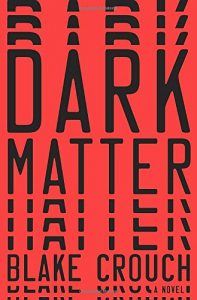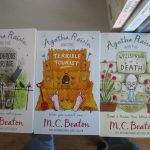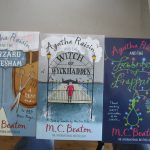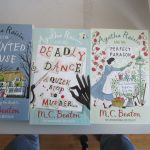Agatha Raisin Series by M. C. Beaton
 They say, the first step is admitting you have a problem ~~ deep breath… here goes…
They say, the first step is admitting you have a problem ~~ deep breath… here goes…
I recently splurged on a book purchase (no surprise there) , but I should clarify it was a “books” splurge (emphasis on the plural) ~~ uh oh.
This artist’s humorous installation (which I don’t find that funny) actually used my house as inspiration. Come on by, if you’re in the neighborhood. I’ll pose for selfies.
As rationalization background, I’ve always preferred British literary editions, their books often are higher quality, lovely in the hand, and their covers are always beautifully designed. Years ago, I returned from Blackwell’s in Oxford with my luggage full of books, a whole other separate box they shipped, and a severely damaged credit card which took me weeks to resurrect.
HERE — just look, you’ll understand.
Just after Christmas, I was telling a British friend about my love for British volumes, and he pointed out an obvious fact (one which somehow eluded me) that I could order books via Amazon UK. They covert British pounds and happily take our American money … SAY WHAAT?
So I set up an Amazon UK account and did some browsing ~~
I know, I know – Danger Danger Will Robinson…
But look, just look what arrived from the UK yesterday – be still my heart.
Ta Da! It’s (almost) the entire series of Agatha Raisin mysteries – direct from the UK! I am so excited I can hardly stand it. And all of them, including shipping (again from the UK) for just a bit over $30 American.
I take no financial reimbursement for this, but I have to mention that Book People UK offered this deal — brand spanking new paperbacks – which arrived perfectly packed and cello-wrapped together – again for an absurdly good price.
(Okay, that’s my opinion – Husband has a different take, but then, he is not one of us – try and forgive him, he really is adorable in all other aspects.)
I have more than my share of guilty pleasures — but let’s stick to reading shall we? I am crazy for the Agatha Raisin mystery series by M. C. Beaton.
Now the more intellectual Book Barmy followers will likely scoff at this series — but as my favorite (British) blogger Simon says – “I care not”. He, too, devours Agatha Raisin mysteries — you see why I consider him a reading buddy.
Now, if you don’t know about Agatha Raisin, let me correct that for you.
Agatha Raisin retired from a successful career in public relations and decided to live her dream of leaving London for a picturesque cottage in the Cotswolds. Don’t worry, she is not a particularly likable character. Agatha is self centered, tends to over indulge, and blurts out whatever is on her mind– with many disastrous and funny results.
Turns out, her idyllic life does not always live up to her dreams — and maybe, just maybe, retirement does not suit Agatha Raisin. She has trouble being ever-so-polite, caring about village gossip, or the dramas. Bravely, Agatha grits her teeth and tries to fit in with the village life.
From a disastrous cooking competition (in which she enters a store bought quiche) to openly scoffing at Women’s Institute activities — Ms. Raisin tries her damnest. And she keeps trying and trying. But don’t count Ms. Raisin out – this is no shrinking violet. Agatha ends up solving the village infractions, serious murders, goes foul of the local constable and falls in (and out) of love. Slowly – ever so slowly, she becomes part of the community – simultaneously befriended, resented and hated.
The series is clever and quirky, filled with a wacky assortment of characters, and snort-out-loud-humor.
But my delight in my new acquisition knows no bounds – just take a look at these precious British covers…and did I mention, they are all brand spanking new?
Click to make larger…you know you want to…
I want to continue the series, (I think I’m at the 5th or 6th) but I’m afraid to crease the spines. But I’m sure to delve into them soon.
Don’t worry you, too, can enjoy the Agatha Raisin mysteries by M. C. Beaton. They are at your local library or can be picked up for a buck or two at any used bookstore.
Pay no attention to the fact that you are reading the tacky American paperbacks with sub-par covers…contents are the same.
As you read, just try not to think of me, as I happily pet and shelve my new British versions.
Okay, that was unseemly — pure gloating.
Best $30 I ever spent.
N.B. The Brits made a television series based on the books. It’s available on Youtube or Acorn TV if you’re interested Link: HERE. I will wait until I’ve finished reading the series (in order, if you please) or I’m drooling in a nursing home — whichever comes first.
Dark Matter by Blake Crouch
 Dark Matter by Blake Crouch
Dark Matter by Blake Crouch
I would never have expected this to be my first read of the new year. In truth, I never would have opened this sci-fi thriller, except for a favorite bookstore customer.
He’s an older gentleman (OK, not that much older) who brings in his once read, bestseller hardbacks to donate — we love patrons like this. Often, he’ll press one into my hands and recommend I read it before donating. His reading tastes run to spy thrillers and political intrigue, so I usually take a look but then put them in the donation box after he’s left.
This time, however, I opened Dark Matter and sat down at the register to give it a try — half an hour later, customers were clearing their throats and uttering plaintive “excuse me”s to get my attention.
I took it home, read very late into the night and then finished it the next (luckily, rainy) morning.
It’s going to be tough to tell you about Dark Matter without spoiling it.
Suffice it to say ….
This is the story of Jason who has a pretty great life, a wife, a son, a comfortable home. He has regrets, a lackluster career, missed opportunities, but overall, he’s content. Walking home, after meeting a friend at a bar, he is abducted and, just before he is injected with a serum, is asked; “Are you happy with your life?”.
He wakes to find his family gone. Not dead, not abducted, but gone — they never existed. His home isn’t where it should be, his life as he knew it, never was. Dark Matter is the tale of Jason trying to get back to the life he so loves.
Like most of us, only after this loss does Jason fully realize that he has (whoops had) everything he could ever want. The power of this love, the anguish of the loss, and his journey to find his (now) lost life is the premise of Dark Matter.
But, that makes the story sound simple and it’s anything but. There’s quantum physics (there’s even a reference to Schrödinger’s cat, which my scientist sister had to explain to me). There are parallel universes (yes that’s plural). And there’s dark matter:
Most astrophysicists believe that the force holding stars and galaxies together—the thing that makes our whole universe work—comes from a theoretical substance we can’t measure or observe directly. Something they call dark matter.
Mr. Crouch writes for television* and his style reflects that medium. The writing simple but powerful.
He also writes in very short sentences.
And fragments.
Like this.
So, you see.
Why it is a quick read.
The other reason Dark Matter is a quick read is that it is ruthlessly compelling. Just when you think you got it, and you know where the book is going – Mr. Crouch hurdles you in whole new direction. I found myself empathizing with poor Jason throughout his quest to get his life back, imagining his turmoil, his loss as my own.
No one tells you it’s all about to change, to be taken away. There’s no proximity alert, no indication that you’re standing on the precipice. And maybe that’s what makes tragedy so tragic. Not just what happens, but how it happens: a sucker punch that comes at you out of nowhere, when you’re least expecting. No time to flinch or brace.
I’m sure you can tell that Dark Matter surprised me. At first appearance this is a sci-fi thriller — in the style of Patterson or Koonz. But the story line is insightful, human and will cause the reader to contemplate their own life and their choices. It’s the Road Not Taken – on a whole new level.
It’s terrifying when you consider that every thought we have, every choice we could possibly make, creates a new world.
Yes, Dark Matter is an adrenaline-fueled thriller, a keep you up all night page turner, but what keeps it from being a cliche is Jason — an authentic, faithful and heart-warming hero, or should I say heroes? – (whoops enough said).
Well, I didn’t see that coming, my first book of the new year – way — way outside of my reading comfort zone and, much to my surprise I fell hard for this book. It’s high entertainment with a heart.
*Mr. Crouch is the creator/writer behind one of my favorite TV series Good Behavior, as well as Wayward Pines (which I don’t know)
The Day I Became an Autodidact by Kendall Hailey
It’s going to rain all weekend, so I just returned from the nutso grocery stores and I’m hunkering in to do some January clean outs. You know, that pile of old tee shirts that I imagine I’ll wear at the gym (if I ever went to the gym) or those stacks of CD’s I never play anymore.
But instead (you knew this was coming) I headed to a seldom used bookshelf in the guest room and searched for books to get rid of. Books are much more fun to sort through than tee shirts.
I came across this book which, from my notes inside, I read in 1990 – a year after it was published.
Should it stay or should it go? Let’s see, shall we?
The Day I Became an Autodidact,
and the Advice, Adventures, and Acrimonies That Befell Me Thereafter
by Kendall Hailey
First, because I had to look it up:
Autodidact: a person who has learned a subject without the benefit of a teacher or formal education; a self-taught person.
You may remember one of my favorite books A Woman of Independent Means by Elizabeth Forsythe Hailey. This autobiography, cum journal comes to us from her precocious daughter when she was just a teenager.
At age fifteen, Kendall decided to throw off the shackles of a formal education after receiving her high school summer reading list:
“Being told what to read by someone else is a violation of basic human rights. Or at least basic literary ones.”
So she graduates high school early, and pursues her own intellectual and artistic interests, at home with her fabulously oddball family – her novelist mother and her father, playwright Oliver Hailey. This is her account of the journey.
Each entry begins with (capitalization is all hers):
WHAT I HOPE TO DO: (Get a Head Start on Reading Everything Ever Published); and ends with WHAT I DID (Had a bumpy first date with Dostoevsky).
Kendall tears through Roman history and Greek plays. Upon reading Aristophanes, she writes:
“Plays about the gods are always fun. It is so comforting to think such cut-ups are running the universe.”
As I thumb through this book, I find my underlining throughout — who would not find an eclectic kindred spirit in a teen who reads and raves about Pride and Prejudice, Life With Father, Anna Karenina and The Murder of Roger Ackroyd.
She raves about Will and Ariel Durrant (whom I’ve never attempted) but I agree with her on Henry James:
“Several readers were reported lost for years in a Henry James sentence.”
The Hailey family is no doubt privileged — they jet off to England to purchase a third home and hobnob at Sardi’s after Broadway openings. Throughout it all, Kendall is a typical teenager, but with an old soul. She has a boyfriend, of sorts:
“We talked for an hour and a half until he had to leave for the orthodontist. It is hard to talk too seriously of love with someone who still has to go to the orthodontist.”
And, has normal teenage angst:
“I have discovered that it does not really matter if I write, read or am nice to people. All that matters is that I lose weight.”
Kendall’s view on nuclear war, while simplistic, struck a cord with me:
“I think everyone who has the power to start a nuclear war should be made to see Our Town at least once a day — until the last thing they want is the power to destroy life. If they could see how precious one life is, perhaps they would stop seeing nine hundred million lives as an endurable loss.”
At times, she is wise beyond her years:
“The world is much too random a place for any of us ever to end up with exactly what we want, but then very few of us are bright enough to know exactly what we want.”
I remember I found The Day I Became an Autodidact schizophrenic — at times irritating, entitled and narcissistic — but also funny, charming and whip smart – just like any normal teenager.
The book is staying for a re-read – now, back to my pile of tee shirts.
After yesterday’s post…
 A kind Book Barmy reader sent this to me after yesterday’s post…
A kind Book Barmy reader sent this to me after yesterday’s post…
Excuse me, but I think I’ll go fondle my books…
Odd, Very Odd
 2016 was a very odd year on many levels, and now we’re into 2017, which promises to be even odder.
2016 was a very odd year on many levels, and now we’re into 2017, which promises to be even odder.
While sipping New Years Eve champagne with friends, I realized 2016, for most everyone, was rubbish – absolute rubbish (I love the British term — rubbish — so much nicer than — garbage)
For me, odd 2016 was a year of being distracted and worried about so many things over which I had no control or influence and yet it affected everything in my life – especially my reading .
Even that normally quiet week between Christmas and New Years was a conga line of interruptions and mad activity. I finished only one (only one!) of my Christmas books. 2016 was very odd:
I lost my reading mojo.
I didn’t do as much reading as I’d planned or even hoped.
I have a toppling stack of books abandoned after reading a few chapters
I had the attention span of a gnat.
So, as I slowly put away the Christmas decorations for another year, it suddenly hit me. For most of the past year I’ve been freaking tired – not sleep deprived tired — but bone weary, beat with sticks, sick of it all tired…
My New Years resolution is to give myself permission to restore.
Restore my focus
Restore just being still
Restore also getting out and being more active
Restore my connection with things that fill me with quiet, simple happiness – a daily walk on the beach, my garden, going out with friends, trying new recipes, my new bicycle, writing a letter or two ~~ and yes reading, but not just reading – but focusing and falling into a book — hard.
A friend just posted this on their Facebook page (see, no attention span, I bounced over to Facebook, even as I write this blog post…)
Hello 2017, as odd as you may be, I’ll be ready for you — after I’ve had a rest.
Hygge days
 It’s my favorite part of the holiday season – that lovely week between Christmas and New Years. When I put on my music and snuggle up in my reading nook.
It’s my favorite part of the holiday season – that lovely week between Christmas and New Years. When I put on my music and snuggle up in my reading nook.
But I’ll take a short break to tell you about an article a friend mentioned from the Sunday New York Times.
It’s all about wintering the Danish way and the concept of Hygge (pronounced HOO-gah) ~~ the Danish word for cozy.
Hygee
(don’t you love saying it? Come on everyone, all together now, ~~ HOO-gah)
is the constant pursuit of homey pleasures involving candlelight, fires, fuzzy knitted socks, porridge, coffee, cake and other people. Yes, I mummered to myself that’s exactly what this week is all about, Hygge. (Except for the porridge bit, shudder.)
You can read the article HERE
I promise to report back soon with my reading adventures.
Happy Hygee everyone.

















